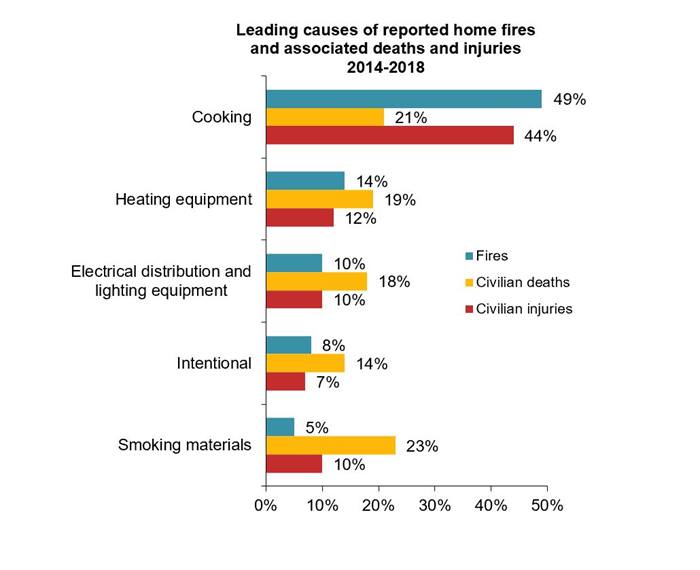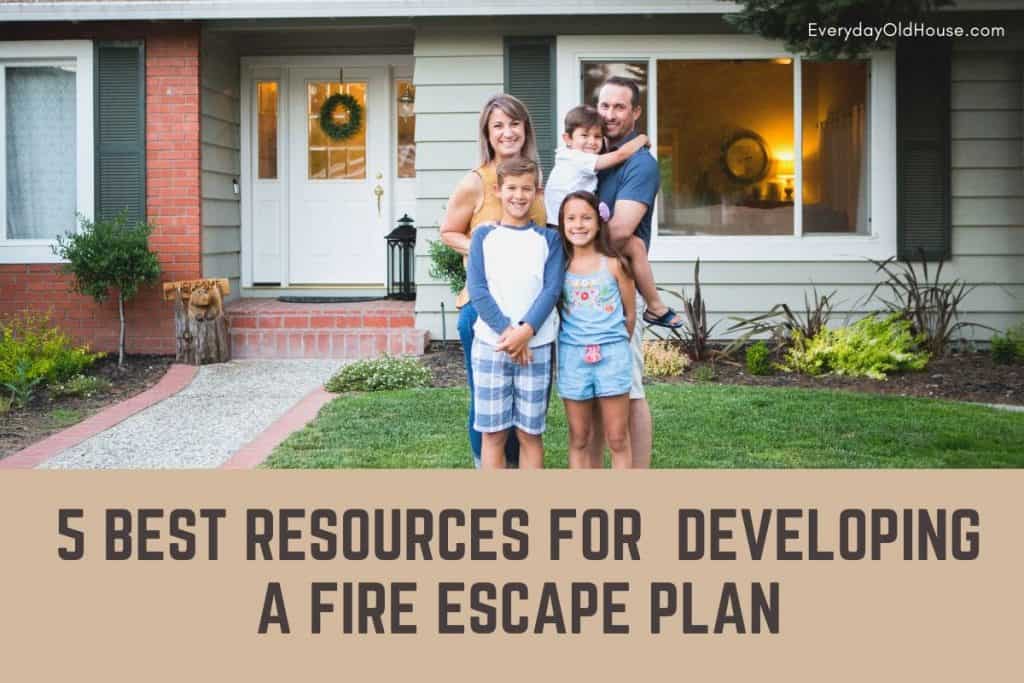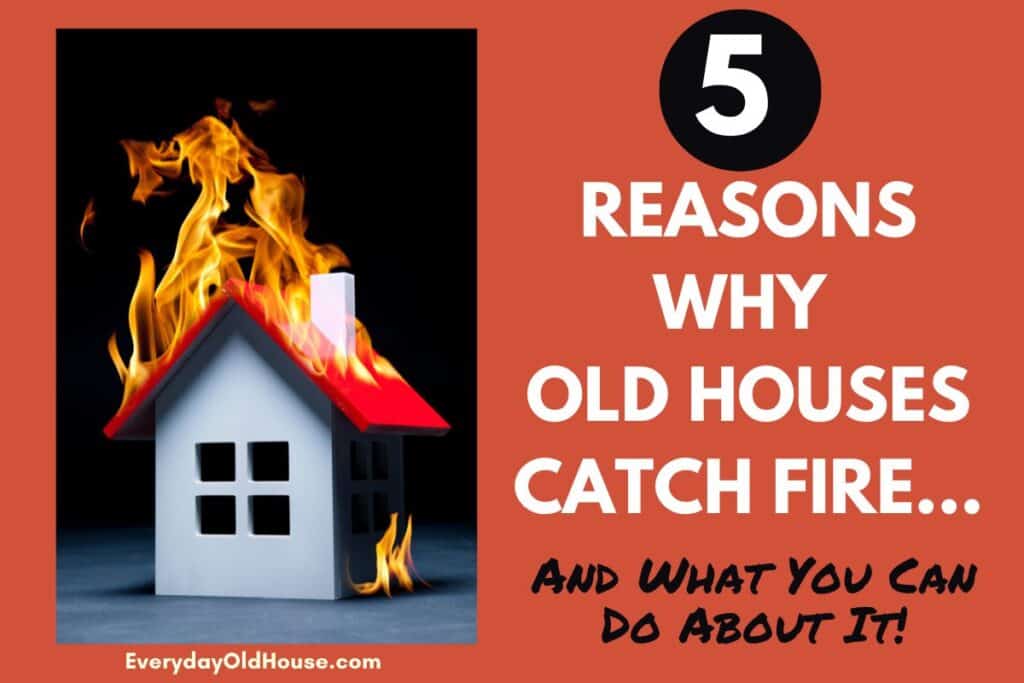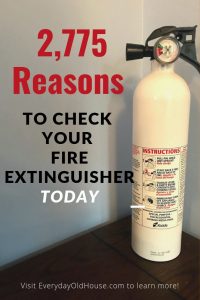Recently while searching for the leak under my kitchen sink, I discovered my fire extinguisher shoved waaaaay in the back of the cabinet. And worse, it was empty! Yikes! Definitely not the right way to keep my family and home safe…. So today I want to remind homeowners about the importance of fire safety with this guide to fire extinguishers -including tips on fire extinguisher buying, storage, use, inspection and disposal from the experts – to ensure a safe home for you and your family.
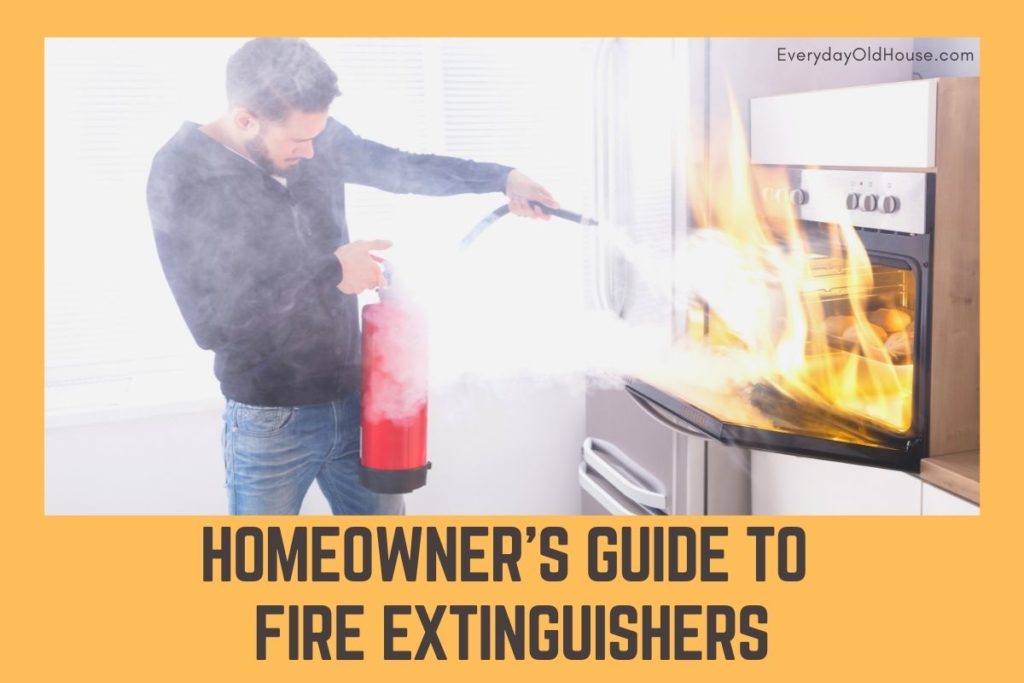
This post contains affiliate links, including but not limited to, Amazon Associates. As such, I earn from qualifying purchases. Full disclosure located here.
Backstory
Recently I noticed that our garbage disposer was leaking. And while fiddling around under the sink I noticed waaaay in the back of the cabinet our fire extinguisher. Hidden behind the extra dish soap, extra sponges, dog bowls, canned dog food, etc…..
Shame on me!
That shouldn’t be in the back of the cabinet! If there was a fire, no one could get to it easily. So I moved it to the front of the cabinet. (And pushed the extra dog food to the back. Sorry puppy!)
Then I noticed something else. The gauge on the fire extinguisher read “EMPTY”!
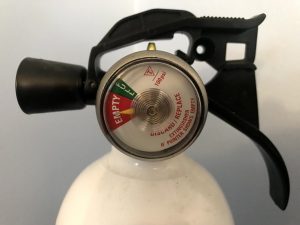
Geez Louise. I’d like to consider myself a responsible homeowner. But clearly this was not the case. Having an empty fire extinguisher hiding in the depths of my kitchen cabinet is not the sign of a savvy homeowner!
So I decided to learn more about fire extinguishers and Fire Prevention and Safety in general and pass it on to you.
I think we can all agree that keeping our homes and families safe is Number 1 Priority. And here’s what I found. I hope it’s helpful!
Disclaimer
Obviously I’m not a fire prevention expert. Just a homeowner trying to help others make their homes safer with a guide to fire extinguishers. If you want to learn more, go directly to the experts I’ve highlighted in this post, especially:
Second, you must understand that a fire extinguisher is just ONE piece of fire safety. Don’t forget to develop a fire escape plan and practice a home fire drill with your family. Experts say this is actually more important than having a fire extinguisher.
Homeowner Guide to Fire Extinguishers
There is a lot of information to cover in a guide to fire extinguishers! I’ve broken it down into these following topics. Click on the link to jump to a specific section.
- Statistics on Fires
- Causes of Fires
- Types of Fire Extinguishers
- Where to Store
- Inspection/ Maintenance
- How to Use a Fire Extinguisher
- How Long Fire Extinguishers Last
- Fire Extinguisher Disposal
- Fire Escape Plans
Statistics on Fires in Homes
As a homeowner, how worried do I need to be about a fire in my house? After reading up on some statistics on home fires, apparently very worried! Why? Here’s a few stats to put things in perspective
- Fires are the 4th largest fatal hazard in home – behind falls, poisonings and carbon dioxide.
- 90% of all fire-related deaths occur at home
- National estimates for residential building fires and losses are:
- Fires: 379,600
- Deaths: 2,790
- Injuries: 11,525
- Dollar loss: $8,194,500,000
- At least 1 child dies per day in a house fire.
- Once a fire starts, occupants have only about 2 minutes to safely escape.
Think about it for a second.
House fires result in 2,775 deaths per year. That equates to 7-8 deaths per day, or 1 death every 3-4 hours.
I don’t like that statistics. Do you?
A significant number of those 2,775 deaths were in homes that lacked fire prevention and safety technology. For example, either they didn’t have smoke detectors at all, or didn’t have working smoke detectors (i.e. dead batteries). Simple, preventable measures that could have saved lives.
Considering the majority of fires are preventable, these stats are not acceptable. None of us want to be part of that statistic. And with a bit of education and preparation, we won’t be.
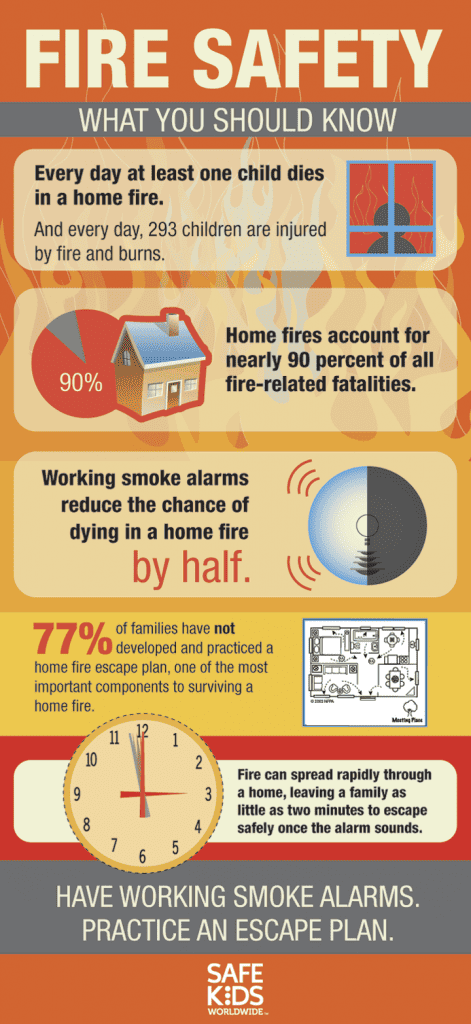
What Causes Home Fires?
I think this chart from the NFPA best summaries causes of home fires.
My take-aways from this chart:
- Cooking causes almost 1/2 of all home fires (48%), but has contributes to proportionally fewer deaths (21%).
- Smoking accounted for a small percentage of fires (5%), but resulted in the greatest percentage (23%) of deaths.
If you want to dive further into the data check out the NFPA’s tools and resources page.
What Types of Fire Extinguishers?
Let’s dive into this guide to fire extinguishers describing the types currently on the market for homeowners. In general, there are 3 types of fire extinguishers to be aware of:
- Classification
- Rechargeable vs Disposable
- Size and Weight
1. Classification
All household fire extinguishers are classified as A, B, or C (or a combination of these). This indicated which types of fires the extinguisher is meant to fight.
A is ordinary combustibles like wood, paper, and cloth. B is flammable liquids, such as gasoline or cooking oil. C is live electricity.
[Note that there are two other types of fire extinguishers (D and K), but these are not commonly types of fire found in homes.]

Do homeowners need to buy 3 different fire extinguishers to fight the 3 common types of house fires? If so, this sounds a bit confusing. I can’t image trying to rack my brain during the panic of a fire trying to figure out which extinguisher to us….
Enter the ABC Fire Extinguisher….
Luckily, homeowners don’t have to. Most home fire extinguishers sold are classified as “ABC”, which means they fight the three common types of house fires. An ABC extinguisher is a dry chemical extinguisher. It uses a fine dry powder to coat the fire’s fuel and cut off its fire’s oxygen supply.
And this is the type of fire extinguisher the NFPA recommends for your house. An ABC extinguisher usually costs more, but it’s a safer and more practical option.
2. Rechargeable vs Disposable
There are rechargeable extinguishers available on the market. A rechargeable one will cost more, but refilling it once the pressure gauge is empty can be less expensive than buying a new disposable one-time use home extinguisher.
3. Size and Weight
Home fire extinguishers come in various sizes ranging from 16 ounces to 10 pounds. The 16 ounce extinguishers are easy-to-use aerosol can that look similar to large cans of sunscreen or bug spray.
Does size matter? Yes. Research shows that larger, heavier extinguishers (i.e. the 10 pounders) deliver more fire retardant faster and longer.
BUT bigger is not always better.
Experts recommend buying the largest fire extinguisher you or other family members can comfortably hold. Consider if you have residents who might have difficulty lifting and holding onto a large canister but old enough and sensible enough to use (i.e. the elderly and older children). Note that a 10 pound fire extinguisher means 10 pounds of retardant. You must add a few more pounds for the container and apparatus.
There is a limited window of time before you must evacuate your house. You are better off having numerous smaller fire extinguishers throughout the house in strategic places than one large one.
My Take-Away for guide to fire extinguishers?
For the home, select a multi-purpose extinguisher (can be used on all types of home fires) that is large enough to put out a small fire, but not so heavy as to be difficult to handle.
Which Fire Extinguisher Did We Purchase?
OK, this all this new-found knowledge on fire extinguishers I was prepared to buy a new fire extinguisher.
Classification?
This was a no-brainer for us. We decided to take NFPA’s recommendations (since they are the experts!) and bought an ABC type fire extinguisher. These usually costs more, but it’s a safer and more practical option.
Rechargeable or Disposable?
We personally preferred a disposable fire extinguisher for two reasons:
- Homeowner reviews note difficulty finding a local company to recharge their fire extinguishers
- Technology is constantly evolving and improving products. I’d rather buy a new fire extinguisher every 5-15 years to have the most recent, top-of-the-line design in fire safety.
Size and Weight?
We knew that we wanted a home fire extinguisher on the smaller side. Why?
- We wanted to ensure our oldest child could easily maneuver it.
- This extinguisher will be stored under the kitchen sink, and it only has so much room.
So how small did we go? The smallest fire extinguishers are 16 ounce canisters. While these aerosol cans looked appealing in size, I was leery. When a room is filling up from smoke and inhibiting my vision, I want to easily find the fire extinguisher. I don’t want to confuse it with canisters of the same size – bug sprays or cleaning products. Plus, some experts warn against their effectiveness or recommend that they only supplement, not replace a normal fire extinguishers. So we stuck with the traditional fire extinguisher.
The extinguisher we need to replace is 3lbs. While I like that size, NFPA’s minimum recommendation for a primary extinguisher is 5lbs. And I just didn’t feel comfortable going against the expert’s recommendations.
Drum roll……
So the verdict is a ABC classification, disposable 5lb home extinguisher!
And I was floored when I did a on-line search for one of these . There are a TON of fire extinguishers on the market!
The major home fire extinguisher manufacturers are First-Alert, Amerex and Kidde. Amazon carries all three manufacturers. Lowes carries the First-Alert, while Home Depot carries Kidde.
Researching on-line reviews of home extinguishers on Safewise, Wire Cutter, and The Spruce, I chose the fire extinguisher (Amerex B500 Rechargeable Fire Extinguisher) that was recommended by 2 of the 3 sites.
What did I personally prefer about the Amerex B500?
- Value: The reviewers on SafeWise called it the “Cadillac of extinguishers”, but it was a similar price to the others. If you could buy a Cadillac at Kia prices, wouldn’t you?
- Awards: It won “Best for Easy Operation” by Safewise.com and “Best Overall” by The Spruce.
- Metal construction: All metal valve construction, aluminum valve versus most peers having plastic hardware. Maybe it’s true, maybe it’s not, but I agree with the reviews that metal hardware over plastic is a better choice.
What didn’t I like about the Amerex B500?
- Weight. Since it has metal parts, it’s slightly heavier than its peers. I’m not convinced my oldest child can hold and use in an every of an emergency. I’m debating about getting a small 2.5lb fire extinguisher to put next to the kitchen sink and training her on that one.
- Size: It’s one of the larger 5lb models on our list. I don’t have significant space under my kitchen sink, but it’s still small enough to fit and still leave space for dog food, dishwasher detergent, etc…
Where to Store Your Fire Extinguisher
The NFPA recommends an extinguisher for each floor, and in the garage (if you have one). Other experts recommend a fire extinguisher for every 600 ft2 of house.
Fire extinguishers should be placed near an exit in an easy-to grab spot. That way you can fight the fire with your back to the door and make a quick escape if flames get out of control.
The below from the Strike First Corporation of America gives suggestions on where on each floor might be the most ideal location to store home fire extinguishers.
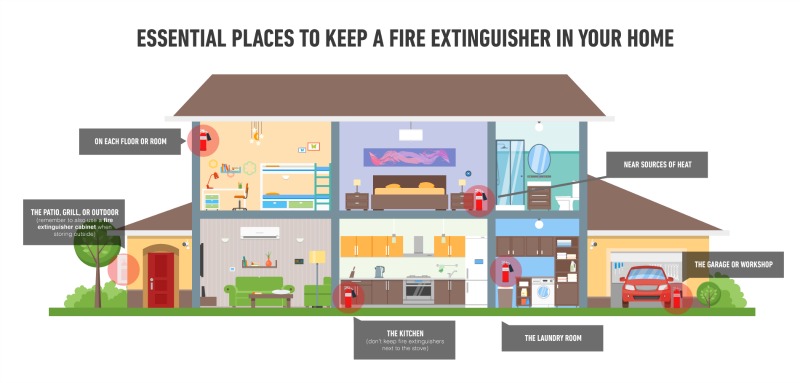
Fire Extinguisher Inspection/ Maintenance
I’ve learned my lesson. Fire safety is more than just having a fire extinguisher. It’s also about being diligent about inspecting our fire extinguishers on a regular basis to make sure we are ready if the unexpected happens.
When Inspect?
Once you have a fire extinguisher in the right spot and ready to go, hopefully you will never use it. BUT you can’t forget about it. According to NFA, a fire extinguisher should be checked monthly.
Why Inspect?
Why check your fire extinguisher? Two reasons – 1) ensure they are still easily accessible and 2) fire extinguishers expire. Over time the seal on the neck of the extinguisher weakens, allowing the compressed gas inside the canister to escape. Once the compressed gas is gone, the extinguishers has lost sufficient pressure to operate.
It appears that expiration dates vary by type of fire extinguisher and manufacturers. But most extinguishers last between 5-15 years.
Sounds like a wide range of years, doesn’t it??
How Inspect?
What should you check to ensure your home fire extinguisher is ready for a fire?
- Gauge is properly charged. (i.e. reads “full”)
- Hoses or nozzles are not cracked or ripped
- Locking pin on the handle is present
- Handle is secure, not wobbly or broken.
How to Use a Fire Extinguisher
Homeowners are responsible to have an idea on how to use an extinguisher before an emergency arises. How do you get familiar with a fire extinguisher?
- First, read the instructions that come with the fire extinguisher. Become familiar with its parts and operation before a fire breaks out.
- Check with your local fire department to see if they offer hands-on fire extinguisher training.
- Learn how to operate a fire extinguisher. The recommended way? Remember the word PASS:
- Pull the pin. Hold the extinguisher with the nozzle pointing away from you, and release the locking mechanism.
- Aim low. Point the extinguisher at the base of the fire.
- Squeeze the lever slowly and evenly.
- Sweep the nozzle from side-to-side.
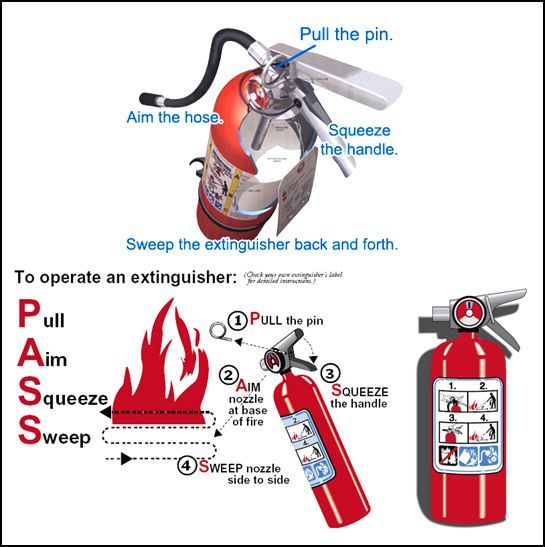
Fire extinguishers are one-time use products. So if you want hands-on practice, you have to buy an extra fire extinguisher. When you consider that this exercise could spare lives and save your house, the cost is worth it.
This video from ACE Hardware shows how the PASS system works.
How Long Do Fire Extinguishers Last?
If you want to know how long your current extinguisher should last, 1) check the tag on your extinguisher for an expiration date or 2) read the instruction manual.
My extinguisher doesn’t have a tag. And truth be told, I don’t have my manufacturer’s instructions. So I can’t check the lifespan of my extinguisher. BUT I know we received this home fire extinguisher as a housewarming gift when we bought the house about 7 years ago. So my fire extinguisher’s expiration date was on the shorter end of the 5 to 15 years.
(As an aside, a fire extinguisher is the BEST housewarming gift. My friend Tara gifts fire extinguishers to every friend who buys a new house. What an awesome friend, right?!)
How Do You Dispose of Expired Fire Extinguishers?
Now that we have a new house fire extinguisher, how do I get rid of the expired one? It doesn’t look like something I can just throw into the trash.
And I’m right.
The chemicals in a fire extinguisher are considered hazardous materials. Even if the gauge reads “empty” there are still some residual chemicals in the canister.
So, what do you do with an old, damaged, or expired extinguisher? Call your local fire or public works department and ask if they accept drop offs. If not, take the canister to a hazardous waste disposal facility.
Final Note on Fire Prevention and Fire Safety…..
Fire extinguishers are just a small (but important part) of a larger plan for fire prevention and safety in your house.
But no matter how many or where these fire extinguishers are located, nothing can substitute for what experts say is the most important fire safety tool – a fire escape plan!
Honestly, we don’t have a plan. We should have one. And now I’m determined to make the family sit down and develop one ASAP. A few months ago we had a fire scare in our kitchen. We were lucky that time. Next time (hopefully there won’t be another time, but…..) we need to be more prepared.
[EDITED: WE HAVE A PLAN NOW! Check out my post on 5 Best Resources to Help You Develop A Fire Escape Plan]
Related Posts

Want to be the first to know about new posts? Be sure to follow me on Pinterest, Facebook, Instagram or Twitter of even Etsy! Or better yet… Subscribe below!
My monthly (admittedly sometimes more, sometimes less….) emails are like receiving a unexpected letter from an old friend WITHOUT needing to put on your slippers and walk out to your mailbox…. See? I got ya, my friend!)
[Note: My posts are proudly connected to these amazing link parties full of DIY ideas and inspiration!]
